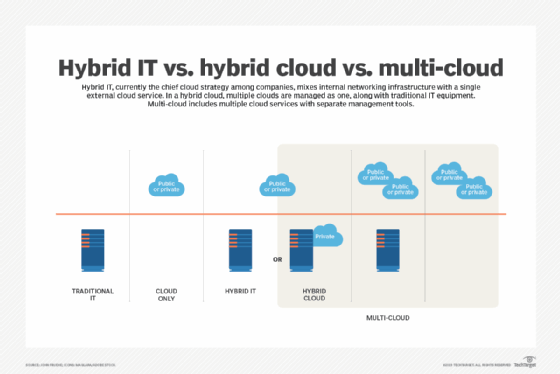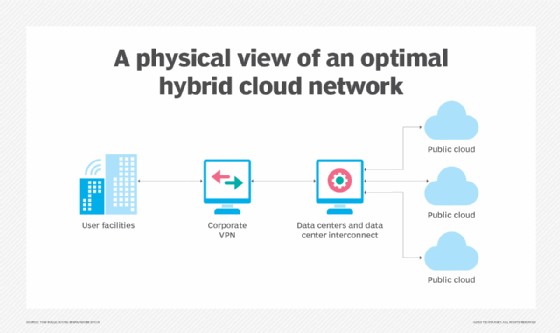Multi-cloud vs. hybrid cloud: The main difference
As businesses digitally transform across increasingly distributed environments, know the benefits, challenges, similarities and differences between hybrid cloud and multi-cloud.
To this day, there's no single cloud solution. Cloud technologies have expanded, matured and proliferated to support the most demanding business needs and use cases.
The proliferation of cloud technologies is particularly confusing to businesses new to cloud adoption, and they're sometimes baffled by the distinction between multi-cloud and hybrid cloud. Both types of clouds have a distinct definition and purpose.
What is multi-cloud?
Although the public cloud infrastructure and public cloud services can be similar among public cloud vendors, public clouds are not directly interchangeable or interoperable. Every public cloud offers a unique set of computing resources and services that are accessed using unique APIs. Every public cloud attempts to be ubiquitous, but differences do exist. And every cloud presents tradeoffs for different business use cases. When a company migrates to the public cloud, that business may eventually adopt a multi-cloud strategy that engages multiple public cloud vendors.
A multi-cloud technology strategy involves two or more cloud computing platforms or cloud vendors to handle various business tasks. The ultimate goal of any multi-cloud strategy is to match the business need with the specific strength of each public cloud. A business might perform some tasks or host certain types of applications on Amazon Web Services (AWS); another set of tasks, apps and data with Google Cloud Platform; and yet other tasks with Microsoft Azure -- all while utilizing cloud applications hosted through various third-party providers.
A multi-cloud approach can be extensive and complex depending on the number of clouds involved and the ways a business consumes each cloud resource or service. For example, a business might employ a public cloud provider's IaaS to host its workloads. At the same time, it could use specialized SaaS or PaaS providers for business services, such as productivity tools (Microsoft 365), employee expense tracking and reporting (Concur Expense) and so on, where each service is its own cloud.
Benefits of multi-cloud
So, why undertake such complexity? There are compelling reasons why a business might explore a multi-cloud approach, including the following:
- Reduces local infrastructure. A business outsources some or all its on-premises infrastructure to third-party providers to shed the burdens of hardware, software, maintenance and support -- for example, moving business email from an in-house exchange server to Microsoft Exchange Online.
- Uses specific services. Clouds often specialize in ways that complement the provider's business background and strengths. A business, for example, might use one cloud provider to host a test and development workload but use a different cloud provider's more mature AI and machine learning (ML) services.
- Manages costs. Local infrastructure requires a capital investment, no matter how or whether it's used. Cloud resources and services employ a pay-as-you-go model in which costs scale based on actual use. A SaaS platform, for example, may charge based on the number of users (seats), while other cloud services charge based on usage or recurring monthly fees. These costs are well documented by providers, and businesses can see that money is spent cost-effectively.
- Improves resilience and compliance. A business must run and remain secure in the face of disruption -- the central tenet of compliance and business continuity. A business might deploy a redundant workload in two or more clouds to handle more application traffic and enhance resilience. If one cloud goes offline, the other cloud can continue to function and support the workload.
- Fosters innovation. Every cloud is different and provides unique strengths and services that other competing providers might not. Adopting a multi-cloud strategy enables a business to engage the unique capabilities of different cloud providers simultaneously rather than facing an undesirable tradeoff of one cloud versus another.
- Avoids cloud vendor lock-in. Dependency on a third-party service provider can become a vulnerability for any modern enterprise. Changes in costs, services, support and other factors can render a business relationship difficult, forcing a costly and disruptive need for change. Using multiple public cloud vendors enables in-house staff to develop expertise with multiple clouds simultaneously and can potentially ease disruptions to the business relationship.

Challenges of multi-cloud
The complexities of a multi-cloud approach extend beyond juggling resources, services and third-party providers. Organizations that embrace a multi-cloud environment potentially face some new risks and challenges rarely posed by on-premises infrastructure, such as the following:
- Security complexity. Multiple cloud providers and environments mean grappling with multiple security configurations and authentication mechanisms to ensure user security, as well as the security of sensitive data. It may be impractical to establish a common security configuration or workflow for all cloud providers. Also, there may be a high risk of security vulnerabilities in multi-cloud environments.
- Regulatory standards. Although multi-cloud strategies can enhance compliance in areas like workload resilience, there are other threats to regulatory compliance, such as improper data storage locations, breaches in data sovereignty regulations or inadequately secured data in the cloud.
- Network security. With workloads and data in clouds, it's unavoidable that sensitive business data traverses a public network, such as the internet. Businesses must take careful precautions to ensure the security of all cloud-related data through encryption, which may be appropriate for data at rest and in flight.
- Provider disruption. A business must consider the implications of network and provider disruption and devise contingency plans. Understand the impacts of an internet outage between the business and provider, a malicious attack on the provider, a deprecation of needed services, or even the effects of a provider merger, acquisition or bankruptcy. It may be necessary to find another suitable cloud provider or repatriate the service in-house.
Multi-cloud management tools
Any organization with a multi-cloud approach must recognize the resources and services it uses, understand their configurations and monitor their performance.
IT teams can use tools to handle multiple clouds from a single interface. These tools support a wide array of cloud platforms, such as AWS and Azure, as well as complementary tools, like Kubernetes to manage container-based workloads. Multi-cloud management tools also should support strong abstraction, orchestration and automation; handle security, such as identity management and data encryption; control policy governance and compliance; monitor performance of the infrastructures and applications; and help manage costs -- often using FinOps-related principles and techniques.
There are numerous tools and platforms currently available to help a business manage multi-cloud environments. Tools and platforms can also vary greatly in their purpose, benefits and interoperability with existing software toolchains. The following is a sampling of multi-cloud management tools:
- Apptio Cloudability.
- BMC Multi-Cloud Management.
- CloudBolt.
- CloudCheckr.
- Cloudify.
- CoreStack.
- Densify.
- Flexera Cloud Management Platform.
- IBM Multicloud Manager.
- Jamcracker Cloud Management Platform.
- Morpheus Data.
- NetApp Spot Cloud Analyzer.
- Nutanix Cloud Manager Cost Governance.
- OpenStack.
- IBM Turbonomic.
- VMware Aria.
It's worth noting that many multi-cloud tools may be used in hybrid cloud environments where the private cloud portion of a hybrid cloud is simply treated as just another cloud to be managed. In other cases, hybrid clouds may also employ management tools that are native to the underlying private cloud software stack, such as the management tools native to OpenStack. Similarly, a hybrid cloud may employ vendor-specific tools included with vendor-based hybrid clouds, such as tools included with AWS Outposts or Google Cloud Anthos.

What is hybrid cloud?
A hybrid cloud technology strategy merges a private cloud, on-premises infrastructure or both with a public cloud environment to create a single cloud computing environment that combines the best characteristics of local and cloud enterprise computing.
A business might create a private cloud to support self-service resource provisioning for software developers or run an important cloud-native application locally. The company can also connect that private cloud to a public cloud to gain extra resources or use specialized services unique to the public cloud provider.
Types of hybrid clouds
The key to a hybrid cloud is uniformity -- consistent access and delivery of resources and services that smoothly integrate public and private clouds. There are two popular approaches to establishing a uniform hybrid cloud infrastructure.
The traditional approach is to build a private cloud stack, using common platforms like OpenStack that can integrate with a public cloud. These are sometimes referred to as heterogeneous hybrid clouds because the resulting hybrid cloud infrastructure includes technologies and platforms from a variety of providers.
Another approach is to use specialized appliances that contain the software stack and services specifically designed to integrate with the desired public cloud. Examples include Azure Stack, Google Cloud Anthos and AWS Outposts. These are sometimes called homogeneous hybrid clouds because the resulting hybrid infrastructure incorporates technologies from a single public cloud provider.
An enterprise must consider the costs, performance and management requirements, as well as the technology roadmap, when choosing the hybrid cloud program that best fits its needs.
Benefits of hybrid cloud
Organizations may choose to add a hybrid cloud strategy for a variety of reasons, including the following:
- Manages costs. Infrastructure is a sunk cost, and some workloads and data always require local infrastructure. So, a business may choose to build a private cloud with on-premises systems that are fast and flexible. Meanwhile, an organization can relocate other workloads and data to the public cloud as needed to take advantage of the pay-as-you-go or pay-per-use models. Merging these public and private clouds into a consistent hybrid cloud enables easy migration of workloads and data as cost benefits allow.
- Provides flexibility. Enterprises implementing a private cloud can benefit from a cloud computing environment, preserve direct control over the actual computing infrastructure and data resources in-house, and draw upon public cloud resources as desired.
- Ensures security and compliance. Some workloads and data must run on local infrastructure for security, compliance and regulatory requirements. A hybrid cloud enables a business to establish and apply consistent security and compliance processes to address regulatory concerns.
- Increases scalability. Workloads may need flexibility to add or drop resources as traffic ebbs and flows. Hybrid clouds enable workloads and data to shift between private and public clouds as demand dictates.
- Improves business agility. Competitive advantages, new business opportunities and faster time to market usually rely on rapid infrastructure provisioning to support activities such as new workload testing, deployment and migration. A hybrid cloud strategy is uniquely suited to this agility. Staff can provision resources on a private cloud and then move workloads and data between public and private clouds.
Challenges of hybrid cloud
While a well-designed hybrid cloud can offer compelling benefits for a busy enterprise, there are also various hybrid cloud drawbacks to consider, including the following:
- Lack of capability. Building a hybrid cloud from scratch, especially a cobbled-together heterogeneous hybrid cloud, can be technically challenging and time-consuming. Not all hybrid cloud projects are successful or meet the organization's expectations. A business must possess solid employee skills and tools before it embarks on a hybrid cloud initiative and proceed in carefully orchestrated phases.
- Costs. While hybrid clouds can benefit overall cost management, it's still expensive to keep and maintain additional private cloud infrastructure, as well as develop new workflows and guidelines for private and hybrid cloud use. Consider all the costs when planning a hybrid cloud project.
- Management issues. Visibility is a crucial element of any infrastructure, enabling a business to understand what workloads are present, how those workloads are running and where those workloads are located. The abstraction of a cloud environment doesn't alleviate business continuity, data sovereignty and other issues. It requires careful management practices and policies using a variety of tools capable of overseeing a hybrid cloud environment.
- Integration problems. The whole point of a hybrid cloud is to integrate a private and public cloud, but in reality, that's one of the biggest challenges. Homogeneous hybrid cloud products make this considerably easier. In addition, the hybrid cloud may require upkeep with changes and updates to match updates to the public cloud provider's infrastructure or software stack.
- Network disruption. Hybrid clouds depend on WAN connectivity. Any disruptions can render the hybrid cloud inoperative.
Multi-cloud vs. hybrid cloud: What are the key differences?
While hybrid cloud and multi-cloud deployment models differ in purpose and infrastructure, they do have some similarities. Hybrid cloud and multi-cloud do the following:
- Provide flexibility and redundancy.
- Enable a business to deploy highly tailored infrastructures.
- Support the transition of capital investments into operational expenses.
By the same token, they have important distinctions, including the following:
- Hybrid clouds always involve public and private clouds, whereas multi-clouds involve only public clouds -- IaaS, PaaS and SaaS.
- Hybrid clouds connect a private and public cloud to establish a single ubiquitous environment, including management, while multi-clouds don't rely on such interoperability, even though some level of interoperability can be achieved.
Can a hybrid cloud be multi-cloud?
Given their similarities and differences, hybrid cloud and multi-cloud are typically regarded as separate approaches or architectures, each with their own purpose. But hybrid clouds and multi-clouds can coexist.
A business can build a private cloud for internal use, merge that private cloud with a public cloud to create a hybrid cloud, and add or integrate multiple other clouds -- whether IaaS, PaaS or SaaS -- to deliver specific resources or services to the business. Similarly, a business could create a hybrid cloud with one public cloud provider but also consume the resources and services of other public clouds outside of the hybrid cloud environment.
It's theoretically possible to create a hybrid multi-cloud, but this would require a private cloud that integrates with two or more public clouds simultaneously. In practice, the complex technical hurdles involved in such simultaneous integrations are rarely worth the effort. Only the largest and most technically adept enterprises with demanding hybrid project requirements should consider such an endeavor.
How to choose which cloud is best for your business
The general criteria for choosing a hybrid or multi-cloud strategy can be reduced to a matter of ownership or control. The choice isn't always obvious or easy, but it should always be driven by specific business needs and goals.
When to choose a hybrid cloud strategy
A business requires cloud flexibility, resources and services but is obligated -- by choice, industry practices or regulatory standards -- to host certain data or workloads locally and can't place the data or workloads outside of the organization's on-premises data centers or direct geopolitical control. For example, a business wants to build cloud-native applications and host some applications in the public cloud but must run certain critical workloads locally. In such cases, building a private cloud for those internal cloud transformations and blending the private cloud with a public cloud for its scope and extended service offerings might be an ideal solution.
When to choose a multi-cloud strategy
A business requires services, resources, infrastructure or cost models provided by specific cloud providers. For example, a business might opt for VM and storage instances from one public cloud provider; business applications, such as productivity or finance, from various SaaS providers; and perhaps AI and ML cloud services or language cloud services from other cloud providers. In these cases, the business doesn't need or desire cloud capabilities on premises, and a multi-cloud strategy might be a suitable solution.
Always choose a cloud architecture based on specific business needs and goals. There is no "best" cloud. Rather, understand the complexities and challenges that each cloud option presents.
Stephen J. Bigelow, senior technology editor at TechTarget, has more than 20 years of technical writing experience in the PC and technology industry.







